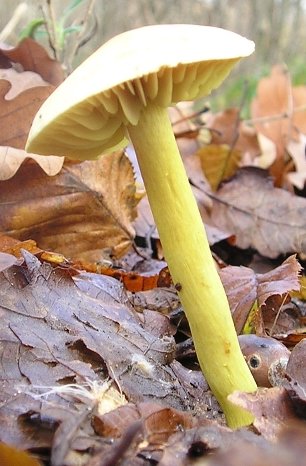The medicinal mushroom Tricholoma sulphureum. The sulphur knight, Tricholoma sulphureum (Bull.) P. Kumm.
Synonyms
Agaricus sulphureus Bull.
Gymnopus sulphureus (Bull.) Gray
Tricholoma sulphureum (Bull.) P. Kumm.
Research suggests that the species Tricholoma bufonium (which is similar in appearance, but with a violet-brown cap color) should be treated as an infraspecific variant of T. sulphureum (Comandini et al., 2004).

My name is Austin Collins.
I've dedicated my life to Mushrooms.
I believe Mushrooms are the best kept secret when it comes to health and well being.
For that reason, I would like to share a company with you that in my opinion makes the best mushroom products on the market.
The company is called Noomadic Herbals, my favorite supplement they make is called "Mushroom Total".
I take their products every day and they have helped me think better and have more energy. Give them a try.
-Austin
Common names
Sulphur cavalier
Sulphur knight
Gas agaric
Stinker
Description
Modifed from Bas, 1988. pg.147 (see Google book preview)
Cap: 2.5-7 cm diameter, hemispherical to convex with margin that is involute to deflexed, irregularly flattened (applanate) with or without slightly depressed center, with deflexed or reflexed margin, with undulating marginal zone, bright yellow with greenish tinge, at center soon with brown to red-brown tinges. Surface dry or slightly moist, satiny to minutely felted-tomentose.
Gills: distant, adnate, usually deeply sinuate, sometimes with decurrent tooth, ventricose, up to 10 mm broad, thick, sulphur-yellow with irregular, concolorous edge.
Stem: 3-7 cm tall x 0.5-1.5 cm diameter, cylindrical, sometimes curved, sometimes broadened or tapering towards base, bright yellow at apex, sulphur-yellow to greenish yellow below, striate with concolorous or darker fibrils, sometimes becoming more or less brownish fibrillose–squamulose with age in lower part. Context yellow.
Smell: unpleasant, very strong, like coal tar gas, also farinaceous when cut.
Taste: very unpleasant, farinaceous-rancid with acrid-bitter component.
Spores: 8-11 x 5-7 um, ellipsoid to oblong, smooth, often irregular.
Spore print: white.
Edibility: inedible – poisonous.
Habitat: solitary or in groups, ectomycorrhizal, associated with deciduous trees (quercus, fagus) rarely also with Pinus sylvestris in woods and at road-sides on sandy soils, probably on slightly richer sites, where the soil is mixed with loam.
Medicinal properties
Antitumor effects
Polysaccharides extracted from the mycelial culture of T. sulphureum and administered intraperitoneally into white mice at a dosage of 300 mg/kg inhibited the growth of Sarcoma 180 and Ehrlich solid cancers by 90% and 80%, respectively (Ohtsuka et al., 1973).
Links
There’s a gallery of pictures at BioPix.
References
Bas C. 1988.
Flora Agaricina Neerlandica: Critical monographs on families of agarics and boleti occurring in the Netherlands. Vol 6. (ME Noordeloos, TH Kuyper, EC Vellinga, Eds.).
Taylor and Francis.
Comandini O, Haug I, Rinaldi AC, Kuyper TW.
Uniting Tricholoma sulphureum and T. bufonium.
Mycol Res. 2004 108(10):1162-71.
Deng H, Yao YJ.
Revision of three species of Tricholoma reported from China
Mycotaxon. 2005 92:77-84.
Ohtsuka S, Ueno S, Yoshikumi C, Hirose F, Ohmura Y, Wada T, Fujii T, Takahashi E.
Polysaccharides having an anticarcinogenic effect and a method of producing them from species of Basidiomycetes.
UK Patent 1331513, 26 September 1973.


